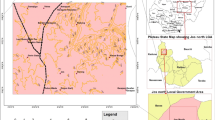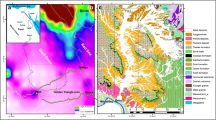Abstract
The determination of groundwater hydrochemical facies (GHF) is useful for analyzing the chemical composition of groundwater, tracking sources of groundwater recharge and assessing how its chemical composition changes along groundwater flowpaths due to water–rock interactions. This paper proposes a geographical information systems (GIS)-based method for identifying and mapping the spatial distribution of GHF categories in an aquifer. Several procedures including spatial interpolation, raster reclassification, raster-to-vector conversion, spatial union overlay, and generalization methods are coupled in GIS tools to determine the type and distribution of GHF categories. This method was implemented to distinguish shallow GHF categories for a shallow aquifer near Fuyang City in Anhui Province, China. The results obtained from the GIS assessment of water quality data from 30 wells show there were seven types of hydrochemical facies identified in the study area. The major GHFs categories are HCO3–Na + K + Ca + Mg, HCO3–Ca + Mg, HCO3–Na + K + Ca, and HCO3–Na + K, which cover 94% of the total area. The GIS method correctly identified the GHF categories determined in 80% of the wells in the area. The major GHFs categories progressively change in the direction of groundwater flow from HCO3–Ca + Mg to HCO3–Na + K+Ca + Mg, then to HCO3–Na + K + Ca, and then to HCO3–Na + K. The changes in the proportions of major ions in groundwater, coupled with salinity increases in the direction of groundwater flow are due to the combined effects of water–rock interactions in the aquifer and human activities. The method can relatively efficiently identify and map GHF zones for aquifers.






Similar content being viewed by others
References
Appleyard S (1995) The impact of urban development on recharge and groundwater quality in a coastal aquifer near perth,Western Australia. Hydrogeol J 3(2):65–75
Back W (1966) Hydrochemical facies and ground-water flow patterns in northern part of Atlantic Coastal Plain. US Geological Survey Professional Paper 498–A
Beckler AA, French BW, Chandler LD (2004) Characterization of western corn rootworm (Coleoptera: Chrysomelidae) population dynamics in relation to landscape attributes. Agr Forest Entomol 6(2):129–139
Chen L, Xie W, Feng X, Zhang N, Yin X (2017) Formation of hydrochemical composition and spatio-temporal evolution mechanism under mining-induced disturbance in the Linhuan coal-mining district. Arab J Geosci 10(3):57
Cloutier V, Lefebvre R, Therrien R, Savard MM (2008) Multivariate statistical analysis of geochemical data as indicative of the hydrogeochemical evolution of groundwater in a sedimentary rock aquifer system. J Hydrol 353(3–4):294–313
Dalton MG, Upchurch SB (1978) Interpretation of hydrochemical facies by factor analysis. Groundwater 16(4):228–233
De Caro M, Crosta GB, Frattini P (2017) Hydrogeochemical characterization and natural background levels in urbanized areas: Milan Metropolitan area (Northern Italy). J Hydrol 547:455–473
El Alfy M, Lashin A, Al-Arifi N, Al-Bassam A (2015) Groundwater characteristics and pollution assessment using integrated hydrochemical investigations GIS and multivariate geostatistical techniques in arid areas. Water Resour Manag 29(15):5593–5612
Elewa HH, Shohaib RE, Qaddah AA, Nousir AM (2013) Determining groundwater protection zones for the Quaternary aquifer of northeastern Nile Delta using GIS-based vulnerability mapping. Environ Earth Sci 68(2):313–331
Environmental Systems Research Institute, Inc. (2014). ArcGIS Help 10.2
Fijani E, Moghaddam AA, Tsai FTC, Tayfur G (2017) Analysis and assessment of hydrochemical characteristics of Maragheh-Bonab Plain aquifer, Northwest of Iran. Water Resour Manag 31(3):765–780
Giménez-Forcada E (2010) Dynamic of sea water interface using hydrochemical facies evolution diagram. Groundwater 48(2):212–216
Giménez-Forcada E (2014) Space/time development of seawater intrusion: A study case in Vinaroz coastal plain (Eastern Spain) using HFE-Diagram, and spatial distribution of hydrochemical facies. J Hydrol 517(2):617–627
Güler C, Thyne GD (2004a) Hydrologic and geologic factors controlling surface and groundwater chemistry in Indian Wells-Owens Valley area, southeastern California, USA. J Hydrol 285(1–4):177–198
Güler C, Thyne GD (2004b) Delineation of hydrochemical facies distribution in a regional groundwater system by means of fuzzy c-means clustering. Water Resour Res 40(12):W12503
Güler C, Thyne GD, McCray JE, Turner KA (2002) Evaluation of graphical and multivariate statistical methods for classification of water chemistry data. Hydrogeol J 10(4):455–474
He X, Liu Z, Qian J, Zhao W, Liu Y (2016) Distribution of nitrate in different aquifers in the urban district of Zhanjiang, China. B Environ Contam Tox 97(2):279–285
Jankowski J, Jacobson G (1989) Hydrochemical evolution of regional groundwaters to playa brines in Central Australia. J Hydrol 108:123–173
Kshetrimayum KS (2015) Hydrochemical evaluation of shallow groundwater aquifers: a case study from a semiarid Himalayan foothill river basin, northwest India. Environ Earth Sci 74(10):7187–7200
Lei Z, Yang S, Xu Z, Vachaud G (1985) Preliminary investigation of the spatial variability of soil properties. Shuili xuebao 9:10–21 (in Chinese)
Lerner DN (2002) Identifying and quantifying urban recharge: a review. Hydrogeol J 10(1):143–152
Li C, Gao X, Wang Y (2015) Hydrogeochemistry of high-fluoride groundwater at Yuncheng Basin, northern China. Sci Total Environ 508:155–165
Li P, Wu J, Qian H, Zhang Y, Yang N, Jing L, Yu P (2016) Hydrogeochemical characterization of groundwater in and around a wastewater irrigated forest in the southeastern edge of the Tengger Desert, Northwest China. Expos Health 8(3):331–348
Li P, Wu J, Tian R, He S, He X, Xue C, Zhang K (2018) Geochemistry, hydraulic connectivity and quality appraisal of multilayered groundwater in the Hongdunzi coal mine, northwest China. Mine Water Environ 37(2):222–237
Lu GY, Wong DW (2008) An adaptive inverse-distance weighting spatial interpolation technique. Comput Geosci 34(9):1044–1055
Ma L, Qian J, Zhao W, Curtis Z, Zhang R (2016) Hydrogeochemical analysis of multiple aquifers in a coal mine based on nonlinear PCA and GIS. Environ Earth Sci 75(8):716
Ma T, Du Y, Ma R, Xiao C, Liu Y (2018) Water-rock interactions and related eco-environmental effects in typical land subsidence zones of China. Hydrogeol J 26(5):1339–1349
Montcoudiol N, Molson J, Lemieux JM (2015) Groundwater geochemistry of the Outaouais Region (Québec, Canada): a regional-scale study. Hydrogeol J 23(2):377–396
Newman BD, Havenor KC, Longmire P (2016) Identification of hydrochemical facies in the Roswell Artesian Basin, New Mexico (USA), using graphical and statistical methods. Hydrogeol J 24(4):819–839
Nur A, Ishaku JM, Yusuf SN (2012) Groundwater flow patterns and hydrochemical facies distribution using geographical information system (GIS) in Damaturu, Northeast Nigeria. Int J Geosci 3(5):1096–1106
Oh HJ, Kim YS, Choi JK, Park E, Lee S (2011) GIS mapping of regional probabilistic groundwater potential in the area of Pohang City, Korea. J Hydrol 399(3–4):158–172
Owen DDR, Pawlowsky-Glahn V, Egozcue JJ, Buccianti A, Bradd JM (2016) Compositional data analysis as a robust tool to delineate hydrochemical facies within and between gas-bearing aquifers. Water Resour Res 52(8):5771–5793
Piper AM (1944) A graphic procedure in the geochemical interpretation of water analyses. Trans Am Geophys Union 25(6):914–928
Qian J, Peng Y, Zhao W, Ma L, He X, Lu Y (2018) Hydrochemical processes and evolution of karst groundwater in the northeastern Huaibei Plain, China. Hydrogeol J 26(5):1721–1729
Raji BA, Alagbe SA (1997) Hydrochemical facies in parts of the Nigerian basement complex. Environ Geol 29(1–2):46–49
Ravikumar P, Venkatesharaju K, Somashekar RK (2010) Major ion chemistry and hydrochemical studies of groundwater of Bangalore South Taluk, India. Environ Monit Assess 163(1–4):643–653
Safarbeiranvnd M, Amanipoor H, Battaleb-Looie S, Ghanemi K, Ebrahimi B (2018) Quality evaluation of groundwater resources using geostatistical methods (case study: Central Lorestan Plain, Iran). Water Resour Manag 32(11):3611–3628
Shah ZUH, Ahmad Z (2015) Hydrochemical mapping of the Upper Thal Doab (Pakistan) using the geographic information system. Environ Earth Sci 74(3):2757–2773
Sheikh MA, Azad C, Mukherjee S, Rina K (2017) An assessment of groundwater salinization in Haryana state in India using hydrochemical tools in association with GIS. Environ Earth Sci 76(13):465
Shi X, Jiang F, Feng Z, Yao B, Xu H, Wu J (2015) Characterization of the regional groundwater quality evolution in the north plain of Jiangsu Province, China. Environ Earth Sci 74(7):5587–5604
Soldatova E, Guseva N, Sun Z, Bychinsky V, Boeckx P, Gao B (2017) Sources and behaviour of nitrogen compounds in the shallow groundwater of agricultural areas (Poyang Lake basin, China). J Contam Hydrol 202:59–69
Stuyfzand PJ (1989) A new hydrochemical classification of water types. Iahs Publ 182:89–98
Sun Z, Ma R, Wang Y, Hu Y, Sun L (2016) Hydrogeological and hydrogeochemical control of groundwater salinity in an arid inland basin: Dunhuang Basin, northwestern China. Hydrol Process 30(12):1884–1902
Vandenbohede A, Lebbe L (2012) Groundwater chemistry patterns in the phreatic aquifer of the central Belgian coastal plain. Appl Geochem 27(1):22–36
Wang P, Yu JJ, Zhang YC, Liu CM (2013) Groundwater recharge and hydrogeochemical evolution in the Ejina Basin, northwest China. J Hydrol 476:72–86
Wu J, Zheng C, Chien CC (2005) Cost-effective sampling network design for contaminant plume monitoring under general hydrogeological conditions. J Contam Hydrol 77(1–2):41–65
Zhang Z, Guo H, Zhao W, Liu S, Cao Y, Jia Y (2018) Influences of groundwater extraction on flow dynamics and arsenic levels in the western Hetao Basin, Inner Mongolia, China. Hydrogeol J 26(5):1499–1512
Acknowledgements
The research is supported by the National Natural Science Foundation of China (No. 41602256 and 41772250) and the Science and Technology Project of Land and Resources of Anhui Province (2016-k-11). The authors are grateful to Jiankui Liu, Zhangxian Yan from Anhui institute of Geo-Environment Monitoring for groundwater samples testing, and Han Qiu from Department of Civil and Environmental Engineering, Michigan State University for good suggestions for the manuscript. The authors extend their gratitude to one anonymous reviewer for his valuable suggestions to improve the manuscript.
Author information
Authors and Affiliations
Corresponding author
Additional information
Publisher's Note
Springer Nature remains neutral with regard to jurisdictional claims in published maps and institutional affiliations.
Rights and permissions
About this article
Cite this article
Ma, L., Qian, J., Yan, X. et al. Using GIS methods for determining the spatial distribution of groundwater hydrochemical facies: a case study for a shallow aquifer in Fuyang, China. Environ Earth Sci 78, 335 (2019). https://doi.org/10.1007/s12665-019-8335-8
Received:
Accepted:
Published:
DOI: https://doi.org/10.1007/s12665-019-8335-8




